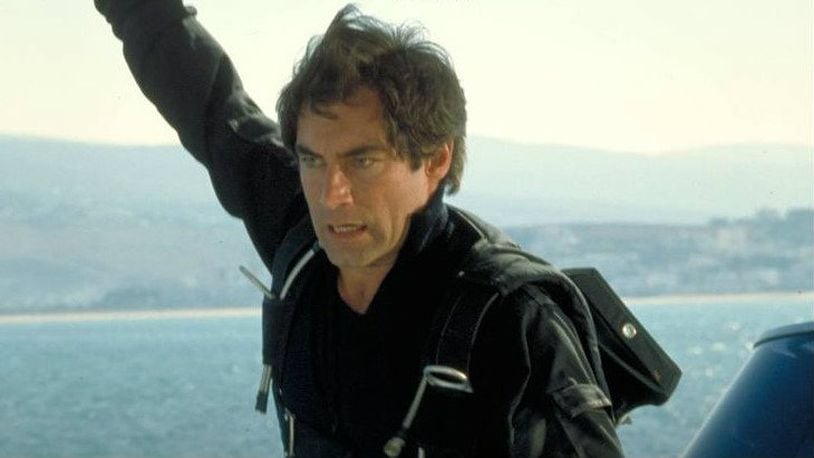››RELATED: When "Star Wars" (finally) came to Springfield
It was 30 years ago this summer that Dalton debuted in “The Living Daylights,” bringing a tougher, no-nonsense Bond and a fresh approach following the action comedy Bonds of the Moore era. It was something of a preview of what Craig would bring almost 20 years later.
As a big Bond fan, I was ready, even if others weren’t. After 12 years of Moore pursued by villains such as Jaws in outer space, it was time for younger blood and back to real secret agent work.
Moore was 57 in his last film, “A View to a Kill,” and seemed out of place fighting younger villains and romancing a woman nearly half his age with Duran Duran on the soundtrack. Released the same weekend as “Rambo: First Blood Part II” didn’t help, as Sylvester Stallone was that summer’s action hero.
“Remington Steele” star Pierce Brosnan seemed the natural successor, and he was. Until NBC, which canceled “Steele” in 1986, decided with all the Bond attention to renew the series, forcing Brosnan to wait another decade before becoming Bond.
Dalton, who Bond producers had supposedly been looking at since the late 1960s when Connery first left, was available and quickly signed. The only thing I remembered him in was the campy 1980 “Flash Gordon” as Prince Barin, which made him more mysterious and fresh, as opposed to Brosnan, who we could see weekly.
Dalton closely resembled the man on the page in the original Ian Fleming Bond novels — and would reveal that as his inspiration for the role, adding to my intrigue.
In addition to introducing a new Bond, “The Living Daylights” came out in the 25th anniversary since the first Bond movie, “Dr. No,” adding excitement.
The film debuted locally on July 31 at the former Regent Theatre, and I was there with three of my closest friends the next night, armed with Raisinets and Dr. Pepper.
The film got off with a bang, including a dramatic skydive followed by Bond hanging off a jeep trying to catch a killer negotiating the curvy Rock of Gibralter with a narrow escape and ending up with a lovely lady on a boat. Classic Bond.
A more serious feel opens the film proper, as Bond helps a Russian general defect, but it’s part of a bigger plot with an illegal arms dealer that took Bond to Czechoslovakia, England, Vienna, Morocco and Afghanistan. Although fantasy, the Bonds often delved into real-world events. This movie came out when the Iran-Contra affair was going on.
While not a save-the-world mission, it features better storytelling and tons of great stunts, including a fight on the back of a cargo net on an in-flight plane and a chase in a gadget-rigged Aston Martin Volante.
What differed was, aside from the girl in the precredits, Bond was a one-woman man, romancing a defecting Czech cellist, a reflection of the AIDS era.
At the center of it all was Dalton. Whereas Moore’s Bond would constantly toss one-liners and cheap jokes and raise an eyebrow, Dalton took it more seriously, not afraid to show fear and anger. But that’s where some moviegoers didn’t take to him.
“The Living Daylights” was a hit, but Dalton’s second Bond film, “Licence to Kill” in 1989, underperformed in the U.S. Perhaps audiences were tired of a suave British spy and instead favored a new breed of action hero, with Arnold Schwarzenegger and the “Lethal Weapon” and “Die Hard” films getting the attention.
››RELATED: Our writer says "Sgt. Pepper's" overrated
Soon after, the Bond series went on hiatus with legal problems, and Dalton quit, making room for Brosnan, which again rejuvenated the series with a more accessible Bond. But some thought Dalton was responsible. For me it was unfinished business.
With Craig’s reinterpretation of the character, some fans got what Dalton was trying to do years before, and a new appreciation of his take was realized. Dalton’s two films are among my favorites, and still it’s his image I see when reading Fleming.
I tip a vodka martini to Dalton and “The Living Daylights.”
Contact this contributing writer at bturner004@woh.rr.com.
About the Author
